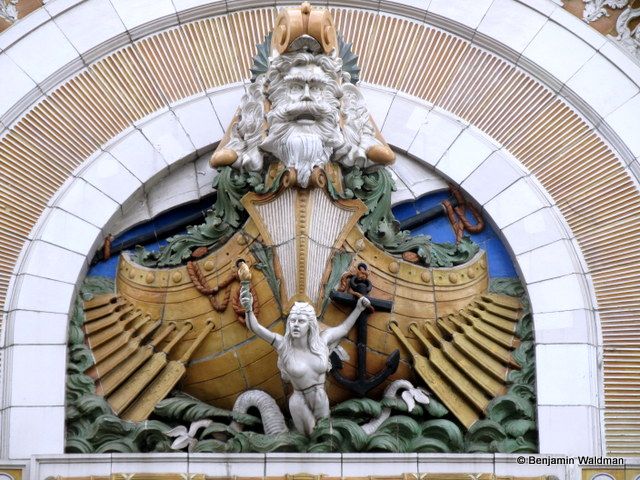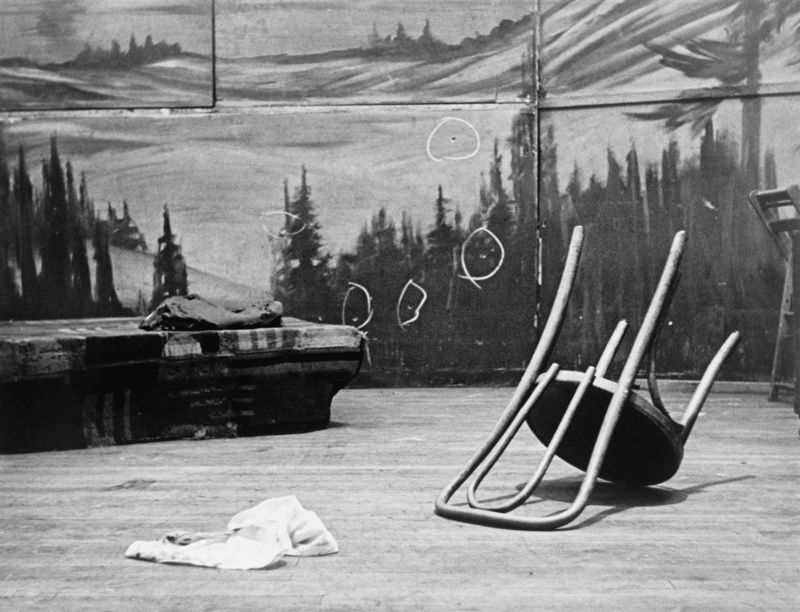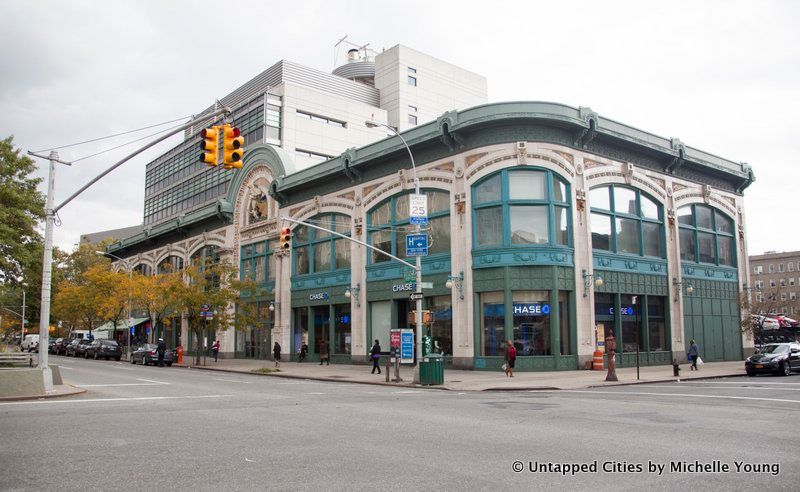Marty Supreme Film Shoot Transforms NYC’s Lower East Side
In October 2024, we reported on a new Timothée Chalamet movie that was shooting on the Lower East Side, and


At 3940 Broadway and West 165th Street once stood the historic Audubon Theater and Ballroom. Constructed in 1912 by Fox Film Corporation founder William Fox, the Audubon Theater and Ballroom was one of the first theaters in the Fox theater group for vaudeville and movies to open in Washington Heights. The building was designed by Thomas W. Lamb, one of the foremost American theater architects, in association with Rambusch Studios, which oversaw the theater’s interior design.
Along its Broadway facade, the Audubon Ballroom featured a three-dimensional polychrome terra cotta design of a boat with the face of Neptune on it, two faces of court jesters, and icons in the form of fox heads to represent the building’s owner. Inside, the Audubon’s 2,500-seat theater was first known as the William Fox Audubon, later known as the Beverly Hills, then the San Juan. With seat boxes adorned with fabric curtains and Bentwood chairs made in the Art Nouveau style, the theater presented some of the most significant vaudeville acts of the early 20th century. Some of these included Smith & Dale, Wheeler & Woolsey, and Fannie Brice. Moreover, the theater became the first in the local community to show early sound films known as “talkies,” with the premiere of Al Jolson’s 1927 film The Jazz Singer.

On the second floor of the Audubon was a ballroom used over the years to host special occasions and events, even serving as a meeting ground for early efforts to organize the municipal transit workers of New York City. The ballroom served as the original meeting hall for the IRT Brotherhood union, often pulling in Michael J. Quill, the founder of the Transport Workers Union of America. During the 1950s, the space held the annual New York Mardi Gras Festival, where a King and Queen of Harlem were crowned. In addition, from 1939 until 1983, Congregation Emes Wozedek, a synagogue of primarily German immigrants, used the Audubon’s basement for religious services.
In 1964, Civil Rights leader Malcolm X left the Nation of Islam and founded the Organization of Afro-American Unity (OAAU), a secular group in favor of Pan Africanism that held weekly meetings at the ballroom. This decision came amidst growing tension with Elijah Muhammad, the leader of the Nation of Islam. At the time, Malcolm X was growing increasingly uncomfortable with Muhammad’s multiple extramarital affairs and illegitimate children. Moreover, he remained in opposition to the Nation of Islam’s decision not to respond to the Los Angeles police department’s repeated acts of violence against Muslims.
The final nail in the coffin came in November 1963, when Malcolm X gave a speech referring to the assassination of President John F Kennedy as “the chickens coming home to roost” after being forbidden to speak on the topic by Muhammad. In retaliation, Muhammad suspended him for 90 days, with no intention of reinstating him, leading Malcolm X to leave the organization. Members of the Nation of Islam came to view Malcolm X as a traitor to their cause, leading to repeated conflicts over the following year. In February of 1964, the Nation of Islam ordered the bombing of Malcolm X’s car. A few months later in June, FBI surveillance recorded a telephone call in which Betty Shabazz, Malcolm X’s wife, was told her husband was “as good as dead,” and days before his death, Malcolm X told interviewer Gordon Parks that the Nation of Islam was actively trying to kill him.

Eventually, the conflict came to a head and on February 21, 1965, Malcolm X was shot multiple times while giving a speech to the OOAU in the Audubon’s ballroom. After being pronounced dead at Columbia Presbyterian Hospital, the autopsy report identified 21 gunshot wounds to his chest, left shoulder, arms, and legs. Three members of the Nation of Islam were charged with the shooting and given indeterminate life sentences, but two were exonerated in November 2021.
Following the shooting, the Audubon Theater and Ballroom were forced to shut down, resulting in the owners being unable to make their property tax payments. As a result, the building was acquired by the New York City government in 1967, though the building continued to operate as the San Juan Theater, showing films that catered to the neighborhood’s growing Hispanic population until 1980.
For years, the Audubon Ballroom and Theater lay abandoned. In 1989, Columbia University and the Port Authority of New York and New Jersey reached an agreement to demolish the Audubon Ballroom to build the Center for Commercial Biotech Research, which would be strategically located across the street from Columbia-Presbyterian Medical Center. The $22 million project was projected to bring new jobs to the Washington Heights area, which had suffered an economic downturn because of the fiscal crisis of the 1970s. Though the project was viewed favorably by city officials including Mayor David Dinkins, many community activists and Columbia University students protested the demolition and sought to preserve the historic building.
Attempts were made to persuade the New York City Landmarks Preservation Commission to give the building landmark status, but these efforts failed after the commission refused to hold a hearing to discuss the Audubon’s designation. Even so, community groups continued to fight for the building’s preservation with the Municipal Art Society assembling a pro bono team of architects who investigated the ballroom’s structure to see if any remnants of the building could be saved. They composed a plan which included the adaptive reuse of the Audubon as Columbia’s new research facility while the original facade would be maintained.

The preservationists were ultimately supported by Manhattan Borough President Ruth Messinger, who was required to approve the project in order for Columbia University to receive public funding. However, The Port Authority discovered a loophole that allowed for the city to secure funding without needing her approval. As a result, in 1990, Messinger advocated for a compromise that allowed Columbia to build what is now the Audubon Business and Technology Center on the northern end of the building while two thirds of the Audubon Ballroom’s original facade was to be preserved and restored. In addition, a portion of the interior ballroom was to be turned into a museum honoring Malcolm X’s legacy, which today is the Malcolm X and Dr. Betty Shabazz Memorial and Educational Center. Opened in 2005, the Shabazz Center seeks to uplift cultural production, radical scholarship, and community-based programming as essential tools toward building a more sustainable and civically-minded society.
Next, check out 7 Places To Remember Malcolm X In NYC On 50th Anniversary of Assassination.
Subscribe to our newsletter